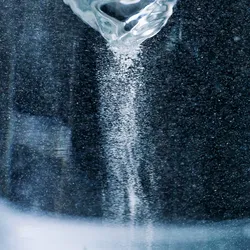
Level 1:
A boat is in the ocean. The boat flips over. You are in the water. You try to not sink. You cannot call for help. What can you do? There is a moving circle in the water - a whirlpool. It pulls you in. You float on top of it without using energy. The air bubbles make you float. A helicopter finds you and saves you. Floating on the whirlpool saved your life.
Level 2:
Imagine you are in a boat on the ocean when suddenly it flips over and you are in the water. You struggle to stay up but cannot signal for help. Is there anything that can save you? Surprisingly, recent studies have shown that whirlpools, which are circular currents in bodies of water, might keep someone afloat. This happens because of the Pouliot effect, which generates air bubbles and creates buoyancy. By conserving energy and floating on top of the whirlpool, one could potentially survive until rescued. However, whirlpools are not always present, and finding them can be challenging.
Full Story:
Can a Whirlpool of Water Save Your Life?
Picture this: you’re out on a boat in the middle of the ocean, and suddenly, your vessel capsizes. You plunge into the water, struggling to stay afloat. In a matter of seconds, you realize that you are far from shore and have no means of signaling for help. Panic sets in as you start to lose energy, and the cold water pulls you down like a weight. In situations like these, one might wonder if anything can save their life. Surprisingly, the answer may lie in a whirlpool of water.
Whirlpools, also known as maelstroms, are circular currents that occur in bodies of water. They often form around underwater obstacles, such as rocks or reefs, and can be dangerous to boats and swimmers. However, recent studies have shown that whirlpools might not always be a threat but could actually be used to your advantage in certain circumstances.
Research has found that some types of whirlpools can create a natural buoyancy effect, which can keep someone afloat for an extended period. The science behind this phenomenon is called the Pouliot effect, named after the French scientist who discovered it. Essentially, when a whirlpool forms, it creates a low-pressure zone in the center. This low-pressure area allows air to get trapped underwater, forming bubbles. These bubbles generate buoyancy, lifting the swimmer towards the surface.
The Pouliot effect was first observed in the 1960s when a helicopter crashed off the coast of Newfoundland, Canada. Three of the four crew members survived by swimming to a nearby whirlpool that kept them afloat until they were rescued. Since then, researchers have studied the effect and found that other factors, such as water temperature and salinity, can impact its effectiveness.
One of the most significant benefits of using a whirlpool for survival is that it requires little energy. In a situation where you are stranded in the middle of an ocean, conserving your energy is crucial. By simply floating in the whirlpool, the natural buoyancy effect can keep you afloat without expending any energy.
While whirlpools might be able to save your life, it’s worth noting that they aren’t always present and can be challenging to find. Additionally, not all whirlpools provide the same buoyancy effect, so it’s essential to understand the specific conditions that create the Pouliot effect.
Overall, while it may seem like survival in the open ocean is impossible, nature has provided us with tools that may increase our chances of staying alive. If you ever find yourself in a situation where you’re struggling to stay afloat without any means of signaling for help, remember that a whirlpool of water could be the answer to your prayers. With this newfound knowledge, you may be able to turn a potentially deadly situation into a successful rescue mission.
Questions:
What is a whirlpool and how does it form?
A whirlpool, also known as a maelstrom, is a circular current that forms in bodies of water. It is typically caused by the interaction between the flow of water and an obstacle, such as rocks, reefs, or changes in underwater topography. When water flows around these obstacles, it creates a rotating motion, resulting in the formation of a whirlpool. The circular movement of water in a whirlpool can vary in size and strength depending on factors such as the velocity and volume of water, the shape of the obstacle, and other environmental conditions.
How can a whirlpool potentially save someone’s life in the water?
A whirlpool can potentially save someone’s life in the water through a phenomenon known as the Pouliot effect. When a whirlpool forms, it generates a low-pressure zone in its center. This low-pressure area allows air to become trapped underwater, forming bubbles. These bubbles create a buoyancy effect, lifting the swimmer towards the surface and helping them stay afloat. By simply floating in the whirlpool, the swimmer can conserve energy and increase their chances of survival in a situation where they are stranded in the water.
Can the Pouliot effect work in any type of water, or are there specific conditions that need to be present?
The Pouliot effect can work in various types of water, but specific conditions need to be present for it to be effective. Factors such as water temperature, salinity (salt concentration), and the size and strength of the whirlpool can impact the effectiveness of the Pouliot effect. Warmer water temperatures generally result in better buoyancy due to increased air solubility. Similarly, higher salinity levels can enhance the buoyancy effect. However, it’s worth noting that not all whirlpools provide the same buoyancy effect, and finding a whirlpool in open water can be challenging.
Do you think it’s important for people to understand the science behind survival in open water situations?
Yes, understanding the science behind survival in open water situations is crucial. Knowledge about natural phenomena like whirlpools and the Pouliot effect can potentially increase one’s chances of survival. It allows individuals to make informed decisions and utilize available resources effectively. Understanding the science behind survival can also help people remain calm and make rational choices when faced with life-threatening situations, potentially improving their chances of rescue or self-rescue.
In your opinion, what would be the most challenging aspect of utilizing a whirlpool for survival?
One of the most challenging aspects of utilizing a whirlpool for survival is the unpredictability and scarcity of whirlpools in open water. Whirlpools are not always present, and their formation depends on specific conditions such as underwater obstacles and water flow patterns. Finding a whirlpool when stranded in the middle of the ocean can be extremely difficult. Additionally, not all whirlpools provide the same buoyancy effect, so identifying a whirlpool with the necessary characteristics to support the Pouliot effect adds an extra layer of complexity to utilizing this survival technique.
Fill in the Blanks:
present, expending, buoyancy, vessel, underwater, phenomenon, capsizes, afloat, conserving, deadly, plunge, potentially, crucial, salinity
Picture this: you’re out on a boat in the middle of the ocean, and suddenly, your ________ ________.
You ________ into the water, struggling to stay ________.
They often form around ________ obstacles, such as rocks or reefs, and can be dangerous to boats and swimmers.
Research has found that some types of whirlpools can create a natural ________ effect, which can keep someone afloat for an extended period.
The science behind this ________ is called the Pouliot effect, named after the French scientist who discovered it.
Since then, researchers have studied the effect and found that other factors, such as water temperature and ________, can impact its effectiveness.
In a situation where you are stranded in the middle of an ocean, ________ your energy is ________.
By simply floating in the whirlpool, the natural buoyancy effect can keep you afloat without ________ any energy.
While whirlpools might be able to save your life, it’s worth noting that they aren’t always ________ and can be challenging to find.
With this newfound knowledge, you may be able to turn a ________ ________ situation into a successful rescue mission.
Vocabulary:
Vessel - a craft for traveling on water, such as a ship or boat
Capsizes - overturns in the water
Plunge - jump or dive quickly and energetically
Afloat - floating in water
Underwater - below the surface of the water
Phenomenon - a fact or situation that is observed to exist or happen
Bouyancy - the ability or tendency to float in water or air
Low-pressure - having a lower atmospheric pressure than its surroundings
Salinity - the concentration of salt in a body of water
Conserviing - protecting something from harm or loss
Crucial - of great importance; decisive
Expending - spending or using up a resource
Present - existing or occurring now
Potentially - with the capacity to develop into something in the future
Deadly - likely to cause death




